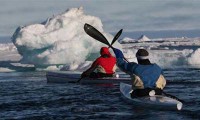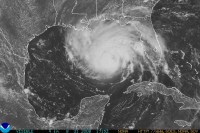By Angeline J. Taylor, Democrat
Warmer seas, particularly in the North Atlantic and Indian oceans, have caused strong hurricanes to be stronger than ever before, according to researchers at Florida State University.
FSU geography professor James Elsner and postdoctoral researcher Thomas Jagger have completed a study on how tropical cyclones are getting strong and ocean temperatures play a role in that trend. Wednesday the two researchers explained how their study, which will be published in the Sept. 4 edition of the journal Nature, impacts the average person. Read more here.
Response by Patrick J. Michaels, Senior Fellow in Environmental Studies, Cato Institute
This is a massively misleading piece by Angeline Taylor. There have been three Category 5 strikes on the US Mainland since good records begin around 1900. They were 1935 Labor Day Hurricane (Florida Keys) 1969 Camille (Mississippi) and 1992 Andrew (Florida). That’s three in 108 years, not one in fifty.
Many more hurricanes reach category 5 status somewhere in their life cycle, usually far out to sea. They then weaken because it is very difficult to maintain this status for long, for a number of well-known physical reasons. One, incidentally, is proximity to a large land area (like the northern Gulf Coast). It appears that when they strike the U.S. they are completing an explosive deepening that often occurs suddenly in their life cycle. That was clearly the case for 1935 (a weak storm in the Bahamas the day before), Camille (which was a minimal hurricane as it passed the western tip of Cuba), and Andrew, which was deepening rapidly when it hit South Florida.
We really don’t know how many storms do this in the historical record because it is very likely in the pre-satellite era (Camille was the first category 5 imaged from space) that many were simply missed as they briefly passed through this threshold. 2005 Katrina was rather typical of many storms in that it touched Category 5 while out in the Gulf but it hit the US as a Cat 3. 2005 Rita did the same, landing as a Cat 3 in Texas. 2005 Wilma hit Cat 5 in the Caribbean and landed in Florida as a 3. 2004 Ivan was Cat 5 around the Caymans and hit Florida as a 3. 2003 Isabel was a 5 in the open Atlantic and hit North Carolina as a 2. Do you see a pattern here?? Calling 2005 Katrina a Cat 5 hit on the U.S. is just wrong. We haven’t had one in 16 years.
See also Chris Landsea’s letter to the press here.
Tom Nelson Blogspot
UPDATE: The diary entry todays as reported by Tom Nelson Blogspot has the Kayaker now becoming stuck in the ice.
“We’re stuck”
I have slept poorly. The floating ice, while thin, is so prevalent that, throughout the night, it grinds noisily against the side of the boat in a slightly alarming fashion - imagine someone scraping their nails across an old-fashioned blackboard.The then begins earlier than normal and, unusually, I am not woken by Robbie bounding into my room. Instead the ship’s engine roars to life earlier than normal - at around 5.30 - and the MV ‘Havsel’ begins to judder ominously. I clamber out of bed and scramble up to the bridge - all the ship’s crew are there, and they look serious. I look outside and I can see why. The sea is almost entirely congested with ice floes - I would estimate 80% plus of the sea is covered by them. There is a real risk that we could get stuck up here. We have drifted in the night into a much icier area than where we stopped last night. I wake up the team, and everyone groggily makes their way to the bridge. There’s a mixed reaction in the team to the prospect of getting stuck up here.
Prior day entry:
My split feelings about this news remind me of another paradox of my expedition up here - the fact that I am spending my days paddling in ice-cold water, with a frozen, painful backside, trying to bring to the attention of the world and its leaders the necessity of stopping the world heating up.
Sam Branson’s Arctic diary - mirror.co.uk
[Sept 1:] Travel this morning was tough. The temperature has dropped dramatically and each time the guys get in the water in is a notch harder. We are starting to see larger chunks of ice, which instead of weaving through, they have to paddle around. The occasional chunk hits the bow of the ship sending small pieces out to the side into the route of travel for our paddlers. One nearly knocked Lewis of his kayak. The water is now below zero and a spill could be quite painful. The moving water by the feet of the guys has started to freeze and this could take a toll on their much needed warmth. I know that Robbie has been struggling with his toes.
[Aug 31:] The ship is noticeably colder and we are all wearing an extra layer. I have been on deck loading the kayaks and boats back onto the ship. The water soaked ropes seep moisture into your gloves and it saps the heat from my hands fast. I can only imagine what it is like for Lewis and Robbie holding on to a cold paddle with waves crashing over them. The first thing Lewis said when he got back in was ‘I can’t feel my backside!’

Compiled by Marc Morano
Before the media starts predictably linking Hurricane Gustav and Hannah to man-made global warming a sampling of a few of the most recent studies should easily silence such chatter. See below report.
1) July 25, 2008 - M.I.T. Scientists: Warming Will Actually Reduce Number of Hurricanes American Meteorological Society report contradicts claim tropical activity increases due to climate change.
2) Recent U.S. Senate report featured latest science on Hurricane and climate link. See full report here/
3) Prominent hurricane expert Kerry Emanuel reconsiders global warming’s impact and Scientist refutes his own theory, finds warming does not increase hurricanes - Excerpt: Emanuel was not disappointed that the research seemed to undercut his old results. “One gets used to being mistaken, and we follow the evidence and sometimes the evidence is contradictory and then we have to sort it out.”
4) ) Another hurricane expert reconsiders view: Study says global warming not worsening hurricanes = Meteorologist Tom Knutson: Excerpt: What makes this study different is Knutson, a meteorologist with the National Oceanic and Atmospheric Administration’s fluid dynamics lab in Princeton, N.J. He has warned about the harmful effects of climate change and has even complained in the past about being censored by the Bush administration on past studies on the dangers of global warming. He said his new study, based on a computer model, argues “against the notion that we’ve already seen a really dramatic increase in Atlantic hurricane activity resulting from greenhouse warming.”
5) Other scientists like Hurricane expert Dr. Bill Gray and Dr. Chris Landsea have steadfastly refuted the alleged warming hurricane link. Excerpt: By suggesting a marked decrease in activity, the new work bolsters the views of Chris Landsea, science and operations officer at the National Hurricane Center, who has argued that the apparent recent increase in Atlantic storm counts is due solely to better observational tools - satellites and the like - which blanket coverage of the Atlantic hurricane basin. “After taking into account the changes in monitoring, the number of storms we’re seeing now is on par with previous busy periods in the Atlantic,” Landsea said.
6) A recent issue of Journal of Climate showing there is little or no evidence of an increase in hurricane numbers or intensity. Paper Excerpt: Little evidence was found that mean individual storm intensity has changed through time, but it is noted that the variability of intensity has certainly increased. Any increase in cumulative yearly storm intensity and potential destructiveness is therefore due to the increasing number of storms and not due to any increase in the intensity of individual storms. Full study here. The paper was authored by Climate statistician Dr. William M. Briggs, who specializes in the statistics of forecast evaluation, serves on the American Meteorological Society’s Probability and Statistics Committee and is an Associate Editor of Monthly Weather Review.

See full size latest image here.
Let me add Governor Bobby Jindal is doing an excellent job coordinating the evacuation and safety measures and communicating to his state’s residents the real threat from Gustav. He has equipped the local officials and agencies with satellite communication devices, REFUSED by the prior governor and mayor during Katrina. That left the state’s and federal resources relying on cell phones useless with no cell towers left standing, unable to communicate with each other and coordinate life saving efforts. Buses sat empty. This time buses and trains were busy evacuating people who have bar codes wrist bands, so they can be tracked. We hope the storm will turn a bit more west as many of the models suggest and the track stays further south though the storm is 400 miles wide so there will be major impact on the state.
By Christopher Booker, Telegraph UK
As the estimated cost of measures proposed by politicians to “combat global warming” soars ever higher - such as the International Energy Council’s $45 trillion - “fighting climate change” has become the single most expensive item on the world’s political agenda. As Senators Obama and McCain vie with the leaders of the European Union to promise 50, 60, even 80 per cent cuts in “carbon emissions”, it is clear that to realise even half their imaginary targets would necessitate a dramatic change in how we all live, and a drastic reduction in living standards.
All this makes it rather important to know just why our politicians have come to believe that global warming is the most serious challenge confronting mankind, and just how reliable is the evidence for the theory on which their policies are based. By far the most influential player in putting climate change at the top of the global agenda has been the UN’s Intergovernmental Panel on Climate Change (IPCC), set up in 1988, not least on the initiative of the Thatcher government. (This was why the first chairman of its scientific working group was Sir John Houghton, then the head of the UK’s Meteorological Office.)
Through a succession of reports and international conferences, it was the IPCC which led to the 1997 Kyoto Protocol, soon to have an even more ambitious successor, to be agreed in Copenhagen next year. The common view of the IPCC is that it consists of 2,500 of the world’s leading scientists who, after carefully weighing all the evidence, have arrived at a “consensus” that world temperatures are rising disastrously, and that the only plausible cause has been rising levels of CO2 and other man-made greenhouse gases.
In fact, as has become ever more apparent over the past 20 years -not least thanks to the evidence of a succession of scientists who have participated in the IPCC itself - the reality of this curious body could scarcely be more different. It is not so much a scientific as a political organisation. Its brief has never been to look dispassionately at all the evidence for man-made global warming: it has always taken this as an accepted fact. In reality the IPCC’s agenda has always been tightly controlled by the small group of officials at its head.
As one recent study has shown, of the 53 contributors to the key Chapter 9 of the latest report dealing with the basic science (most of them British and American, and 10 of them associated with the Hadley Centre, part of the UK Met Office), 37 belong to a closely related network of academics who are all active promoters of the official warming thesis. It is on the projections of their computer models that all the IPCC’s predictions of future warming are based.
The idea that the IPCC represents any kind of genuine scientific “consensus” is a complete fiction. Again and again there have been examples of how evidence has been manipulated to promote the official line, the most glaring instance being the notorious “hockey stick”. “In particular I am referring to the arrogance, the activities aimed at shutting down debate; the outright fabrications; the mindless defense of bogus science; and the politicisation of the IPCC process and the science process itself.”
Yet it is at just this moment, when the IPCC’s house of cards is crumbling, that the politicians of the Western world are using it to propose steps that can only damage our way of life beyond recognition. It really is time for that “counter-consensus” to be taken seriously. Read full story here.
CBC News
Fruit growers in B.C.’s southern Okanagan valley are counting their losses after unseasonally brutal weather destroyed much of this year’s crop. Officials estimate 100 fruit growers in the Osoyoos area suffered significant losses after heavy frost in April followed by hail, rain and a fierce windstorm in July wiped out much of the fragile crops. Spring frosts killed fruit blossoms in other areas of the region as well.

Cherry crop in the valley is normally worth $50 million on the retail market. See large image here
With its hot summer temperatures and intensive irrigation systems, the Okanagan is one of the most productive agricultural areas in B.C. But for orchardists like Ranbir Kambo, this year’s crop of apples, cherries and apricots is a total writeoff. “Everything is history. There is nothing we can salvage - 98 per cent damage. There is no way anybody could salvage anything out of it,” Kambo said as he walked through his 18-acre fruit orchard in Osoyoos on Wednesday.
He is not alone. Ken Ziebart, the claims monitor for the Ministry of Agriculture, said the government is still tallying the losses, but it estimates it will pay out more than $5 million dollars in insurance payments, one of the largest payouts for the region in recent years.
Read more here.
Big Sky Business Journal
If planet earth is warming, it wouldn’t be the first time. If planet earth is cooling, it wouldn’t be the first time, either. In all of Leighton Steward’s studies about the temperature of the earth, graph lines are always sliding up or down. Going back to the beginning of the planet, 4.6 billion years ago, “I’ve never found a flat line,” said Steward. “Earth’s temperature is always increasing or decreasing.” There are actually 18 factors that influence the temperature of the earth, making for very complex and still largely unknown impacts, Steward told attendees of the Montana Petroleum Association, held recently in Billings. Steward has authored a book on his research, called ”Fire, Ice and Paradise.”
Energy from the sun, earth’s orbit, earth’s tilt and wobble, water vapor, methane, ocean current, plate tectonics, elevation of land masses, chemical weathering, meteorites, volcanoes, vegetation, albedo (reflection of solar heat), cosmic rays – all are climate drivers, with varying degrees of impact at different times in earth’s history.
One certainty, however, is that earth has been very much warmer than it is now - “That’s why we find dinosaur bones all the way to the poles,” said Steward. During the Crustacean Period, earth’s average temperature was 80 degrees - compared to the average temperature now of 59 degrees. And, earth has been much colder than it is now. “Ithaca, New York was 1.8 miles under snow and ice just 11,000 years ago,” according to Steward. The other certainty, as far as Steward is concerned is it doesn’t get much better than it is right now. “Paradise is what we are living in right now,” he said. Hence the title of his book - Fire, Ice and Paradise. Earth began extremely hot, and it has plunged into ice ages many times - eight glacial cycles over the last million years alone.
We are living in a time of relative perfection in terms of earth-s temperature, according to Steward - it’s a time of paradise. “It’s been paradise in particular because of oil, gas and coal,” he added. Another aspect of the science that Steward is pretty confident about is that CO2, carbon dioxide, doesn’t have the impact on temperature that Al Gore claims. While there is some correlation between earth’s temperature and CO2 levels, the data coming from many different sources, says over and over again that the CO2 levels are a “lagging indicator”. That means just the opposite of what the former presidential candidate is claiming - CO2 levels are not driving temperature change, but are affected by temperature change.
That information has been “out there” since 1999, said Steward. No scientists have ever stepped forward to attempt to refute it, he continued. Gore has access to that information, said Steward. Why he is proselytizing the message puzzles Steward. “He won’t debate this subject,” said Steward, but maybe he has come to understand it - “maybe that’s why he has cancelled the last six months of his tour.”
Awarding-winning environmentalist and geologist Leighton Steward is a recognized environmentalist and conservationist for his work on preserving wetlands, Steward has a Master of Science Degree in Geology, twice chaired the Audubon Nature Institute and is currently the chairman of the Institute for the study of Earth and Man at SMU. He is a former member of the Advisory Board of the Lamon-Dougherty Earth Observatory at Columbia University and has received numerous environmental awards, including the EPA’s award for environmental excellence and the API’s Gold Medal Award for his company’s leadership in voluntary environmental practices.
By Siw Ellen Jacobsen, the Research Council of Norway
Pal Brekke was second-in-command of the gigantic international solar research project SOHO. Now back in his home country of Norway, Dr. Brekke is immersed in coordinating research and disseminating findings for the Norwegian Space Centre in Oslo. He is bringing knowledge from his field of speciality into the climate debate, which has branded him as a climate bully in certain circles. The vast majority of researchers concur that anthropogenic activity has affected the earth’s climate. Dr. Brekke is no exception. But he breaks rank with most climate researchers when he expresses doubt as to the actual extent of the impact of human activity.
The UN Intergovernmental Panel on Climate Change (IPPC) has determined that the earth’s temperature has risen by about 0.7° C since 1901. According to Dr Brekke, this time period coincides not only with an increase in human-caused greenhouse gas emissions, but also with a higher level of solar activity, which makes it complicated to separate the effects of these two phenomena. For this standpoint, he has been accused of being in the pocket of the powerful Norwegian petroleum industry and of being the mouthpiece for the country’s least environmentally focused political forces.
Some climate researchers have told Dr Brekke that he is unqualified to put forth his opinion since he is not a climate researcher. Dr Brekke asks, “Just what makes someone a climate researcher? Couldn’t someone who studies solar radiation also be considered a climate researcher?” Dr Brekke has published more than 40 scientific articles on the sun and on the interaction between the sun and the earth. “We could be in for a surprise,” he cautions. “It’s possible that the sun plays an even more central role in global warming than we have suspected. Anyone who claims that the debate is over and the conclusions are firm has a fundamentally unscientific approach to one of the most momentous issues of our time.”
“There is much evidence that the sun’s high-activity cycle is levelling off or abating. If it is true that the sun’s activity is of great significance in determining the earth’s climate, this reduced solar activity could work in the opposite direction to climate change caused by humans. In that case,” contends Dr Brekke, “we could find the temperature levelling off or actually falling in the course of a 50-year period” - an assertion that provokes many climate researchers. Read more here.

The sun today, the 36th straight day without a sunspot heading for first spotless months since 1913?
Scientific Alliance August 22nd Newsletter
The debate about our future energy security continues. Although there has been a significant fall in the price of oil, this is unlikely to reduce the momentum of the effort to find alternatives for both the medium and long term. Much of the argument we hear relates to transport, a very obvious sector with seemingly inexorable growth. But transport has very specific needs because it cannot be connected continuously to a distributed energy source (with the exception of electric trains, of course); it is different from out other main uses of energy.
A more realistic way of looking at the whole energy issue for now might be to concentrate on electricity generation while developments in transport fuel are in any case carried on in parallel. Whether or not viable alternatives are found for conventional petrol and diesel is immaterial as far as power generation is concerned: more power stations will still need to be built. Indeed, the two alternatives to internal combustion engines which have been promoted most are fully electric cars or hydrogen-fuelled cars using fuel cells. Both would need a large increase in generation capacity, and the sooner the current system evolves and adds viable additional capacity capable of meeting base load requirements, the sooner we could be in a position to change personal transport.
Consider a case where battery technology advances to the stage where affordable electric cars capable of long distance travel become a reality, and the problem of rapid recharging or battery exchange is overcome. A large and rapid investment in new generation capacity would be needed, or the roll-out of the new technology would be delayed by many years. But we don’t yet know what mix of generating capacity will we have in a few decades’ time.
Renewables - wind, solar, hydro, wave, tidal and biomass power - at present make a rather small contribution to the total energy mix in the EU. A few countries (Denmark in particular) have a significant proportion of their total generating capacity in the form of wind farms, but this is only viable because they can import electricity from (and export it to) neighbouring states to balance supply and demand. Germany has a generous feed-in tariff as a subsidy for photovoltaic installations, which are not surprisingly much more common than across the rest of Europe. But overall the trend is towards a future where nuclear or “clean” coal (with carbon dioxide sequestration) provide the base load, with renewables contributing a minor share.
It comes as something of a surprise, therefore, to hear Nick Clegg, leader of the Liberal Democrats in the UK, claiming that there should be no more coal or nuclear power stations built, and that the country could be self sufficient in energy from wave, biomass, wind and solar power. In an interview with BBC Radio 4 to mark the launch of his somewhat startling vision, he said “The government has spooked everyone into thinking that we need nuclear by saying there’s going to be a terrible energy gap - the lights are going to go out in the middle of the next decade. There’s actually no evidence that’s the case at all. They’ve raised the wrong problem in order to push the wrong solution.”
On the other hand, the Tory shadow business secretary, Alan Duncan, has his own rather blunt assessment of Mr Clegg’s views: “His overall conclusions defy reality. To deny the looming energy gap and to pretend that with his policies he can realistically become the prophet of total energy independence for the UK is irresponsible and verges on the loopy.” Read more here. Go to Newsletters


